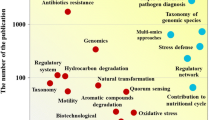Abstract
The thickness and antigenic properties of biofilms produced by Azospirillum brasilense Sp245 and its mutants deficient in the synthesis of lipopolysaccharides (Lps) and calcofluor-binding polysaccharides (CBPS) at the interface between water and hydrophilic or hydrophobic solid surfaces were compared. The mutants deficient in acidic LpsI synthesis produce thicker biofilms on hydrophilic surfaces. Biofilms produced on hydrophobic surfaces by bacteria that are unable to synthesize CBPS are less pronounced. Defects in CBPS production in Azospirillum mutants with impaired flagellar motility can cause adverse effects on the cell ability to attach to hydrophobic and hydrophilic surfaces. The loss of the neutral LpsII antigen by the mutants capable of producing CBPS does not affect their behavior on hydrophobic surfaces, which is probably due to the compensatory increase in the total polysaccharide production. The fundamental change in the Lps structure correlates with the activation of biofilm formation by the relevant mutants on hydrophilic and hydrophobic surfaces.
Similar content being viewed by others
References
Nikolaev, Yu.A. and Plakunov, V.K., Biofilm—“City of Microbes” or an Analogue of Multicellular Organisms?, Mikrobiologiya, 2007, vol. 76, no. 2, pp. 149–163 [Microbiology (Engl. Transl.), vol. 76, no. 2, pp. 125–138].
Molekulyarnye osnovy vzaimootnoshenii assotsiativnykh mikroorganizmov s rasteniyami (Molecular Bases of the Relationships between Associative Micro-organisms and Plants), Ignatov, V.V., Ed., Moscow: Nauka, 2005.
Katzy, E.I., Matora, L.Yu., Serebrennikova, O.B., and Scheludko, A.V., Involvement of a 120-MDa Plasmid of Azospirillum brasilense Sp245 in the Production of Lipopolysaccharides, Plasmid, 1998, vol. 40, no. 1, pp. 73–83.
Matora, L.Yu. and Schegolev, S.Yu., Antigenic Identity of the Capsule Lipopolysaccharides, Exopolysaccharides, and O-Specific Polysaccharides in Azospirillum brasilense, Mikrobiologiya, 2002, vol. 71, no. 2, pp. 211–214 [Microbiology (Engl. Transl.), vol. 71, no. 2, pp. 178–181].
Baldani, V.L.D., Baldani, J.I., and Döbereiner, J., Effects of Azospirillum Inoculation on Root Infection and Nitrogen Incorporation in Wheat, Can. J. Microbiol., 1983, vol. 29, no. 8, pp. 924–929.
Katsy, E.I., Borisov, I.V., Petrova, L.P., and Matora, L.Yu., The Use of Fragments of the 85-and 120-MDa Plasmids of Azospirillum brasilense Sp245 to Study the Plasmid Rearrangement in This Bacterium and to Search for Homologous Sequences in Plasmids of Azospirillum brasilense Sp7, Genetika, 2002, vol. 38, no. 2, pp. 182–189 [Russ. J. Genetics (Engl. Transl.), vol. 38, no. 2, pp. 124–131].
Eskew, D.L., Focht, D.D., and Ting, I.P., Nitrogen Fixation, Denitrification, and Pleomorphic Growth in a Highly Pigmented Spirillum lipoferum, Appl. Environ. Microbiol., 1977, vol. 34, no. 5, pp. 582–585.
Ferriére, L. and Clarke, D.J., The RcsC Sensor Kinase Is Required for Normal Biofilm Formation in Escherichia coli K-12 and Controls the Expression of a Regulon in Response To Growth on a Solid Surface, Mol. Microbiol., 2003, vol. 50, no. 5, pp. 1665–1682.
Petrova, L.P., Matora, L.Yu., Burygin, G.L., Borisov, I.V., and Katsy, E.I., Analysis of DNA, Lipopolysaccharide Structure, and Some Cultural and Morphological Properties in Closely Related Strains of Azospirillum brasilense, Mikrobiologiya, 2005, vol. 74, no. 2, pp. 224–230 [Microbiology (Engl. Transl.), vol. 74, no. 2, pp. 188–193].
Sambrook, J., Fritsch, E.F., and Maniatis, T., Molecular cloning: A Laboratory Manual, 2nd ed. Cold Spring Harbor: Cold Spring Harbor Laboratory Press, 1989.
Lindahl, A., Faris, A., Wadstrom, T., and Hjerten, S., A New Test Based on ’salting out’ To Measure Relative Surface Hydrophobicity of Bacterial Cells, Biochim. Biophys. Acta, 1981, vol. 677, nos. 3/4, pp. 471–476.
Matora, L.Yu., Shvartsburd, B.I., and Shchegolev, S.Yu., Immunochemical Analysis of O-Specific Polysaccharides from the Soil Nitrogen-Fixing Bacterium Azospirillum brasilense, Mikrobiologiya, 1998, vol. 67, no. 6, pp. 815–820 [Microbiology (Engl. Transl.), vol. 67, no. 6, pp. 677–681].
Enzyme-mediated immunoassay, Ngo, T.T., and Lenhoff, H.M., Eds., New York: Plenum, 1985 [Russ. Transl. Immunofermentnyi analiz, Moscow: Mir, 1988].
Author information
Authors and Affiliations
Corresponding author
Additional information
Original Russian Text © A.V. Sheludko, O.V. Kulibyakina, A.A. Shirokov, L.P. Petrova, L.Yu. Matora, E.I. Katsy, 2008, published in Mikrobiologiya, 2008, Vol. 77, No. 3, pp. 358–363.
Rights and permissions
About this article
Cite this article
Sheludko, A.V., Kulibyakina, O.V., Shirokov, A.A. et al. The effect of mutations affecting synthesis of lipopolysaccharides and calcofluor-binding polysaccharides on biofilm formation by Azospirillum brasilense . Microbiology 77, 313–317 (2008). https://doi.org/10.1134/S0026261708030107
Received:
Published:
Issue Date:
DOI: https://doi.org/10.1134/S0026261708030107




